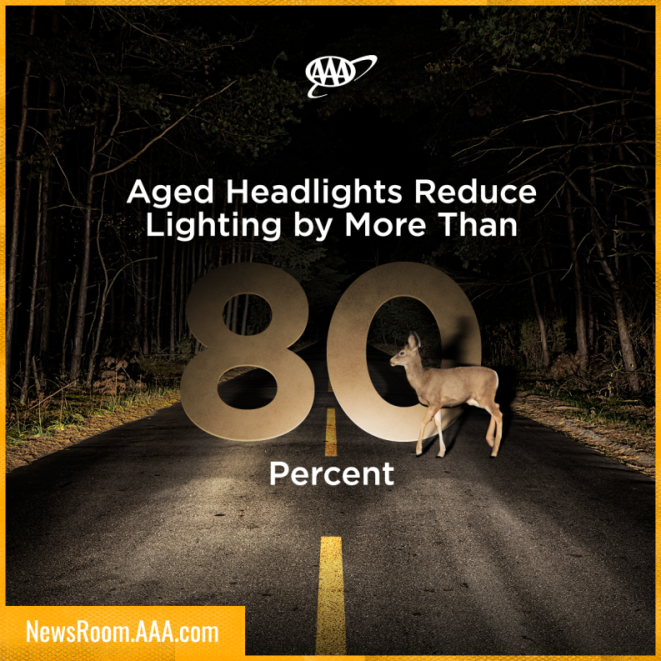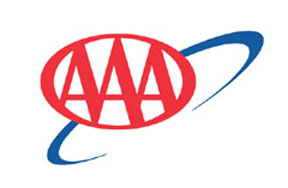|
|
NEWS RELEASE CONTACT: Matt Nasworthy, Florida Public Affairs Director, AAA- The Auto Club Group, |
AAA ILLUMINATES THE DANGERS OF DRIVING WITH CLOUDY HEADLIGHTS
Deteriorated Headlights Produce 80 Percent Less Light Than When New
Headlight B-Roll Video (Click here to preview and download)
TAMPA, Fla. (December 11, 2018) –New test results from AAA indicate that clouded or yellow headlights only generate a little over 20 percent the amount of light that new headlights do, leading to dangerous nighttime driving conditions even with the most advanced headlight systems. AAA urges drivers to check their headlights for signs of deterioration and invest in new headlights or, at a minimum, a low-cost service to boost the safety of driving after dark.
“Clouded or yellow headlights are a safety issue,” said Matt Nasworthy, Florida Public Affairs Director, AAA – The Auto Club Group. “In some states, motorists can be ticketed for headlights that significantly reduce visibility.”
AAA examined the impact deterioration can have on the amount of light produced by conducting research using an accredited laboratory to test headlights from two popular sedans, approximately 11 years in age. Results from the degraded headlights were measured against new headlights to quantify the amount of light produced for each. All testing was done in accordance with the Federal Motor Vehicle Safety Standard 108 as set forth by the Department of Transportation (DOT).
Research revealed that deteriorated headlights, when used on low beam, provided just 22 percent of the amount of light a new headlight does when operating at full capacity. AAA also examined the effects that replacing or restoring a headlight can have on improving the amount of light produced. Replacing headlights with original equipment manufacturer parts is the most effective method to restore light output back to 100 percent.
Aftermarket parts also performed well, restoring light output between 83 and 90 percent, however these did fail to meet certain requirements for light intensity and were found to be more likely to produce glare for oncoming traffic. Restoring headlights, while the most cost effective option, offered less of an improvement in light output than replacement. Professional and DIY restoration returned light output back to approximately 70 percent. Both restoration methods, however, produced more glare than is acceptable according DOT criteria.
Compounding the problem of driving with deteriorated headlights is the fact that U.S. headlights have significant shortcomings. Previous AAA research found that halogen headlights fail to safely illuminate unlit roadways at speeds as low as 40 mph, with high beam settings offering only marginal improvements. Even the most advanced headlights tested illuminated just 40 percent of the sight distances that the full light of day provides. By not maintaining headlights, drivers are unknowingly operating in dangerously dim conditions.
AAA RECOMMENDATIONS FOR NIGHTTIME DRIVING
- When driving at night on unlit roadways, use high beams whenever possible.
- Monitor and adjust driving speeds when traveling on unlit roads at night to allow enough time to detect, react and stop the vehicle in order to avoid striking pedestrians, animals or objects in the roadway.
- If your car’s headlamp lenses are not crystal clear, have them restored, this will provide a noticeable increase in visibility, and reduce the glare from other motorist.
- If you are 60 or older and headlight glare is an issue, have your eyes checked by a medical professional. Cataracts that cloud the eye’s lens may be contributing to the problem.
Unlike batteries or tires, most drivers are not in the habit of routinely inspecting their headlights. AAA suggests drivers check their headlights for changes in appearance such as yellowing or clouding and if the bulb is difficult to see, it is time to have the lenses replaced or restored as soon as possible. AAA recommends replacement since this method offers the most improvement in the amount of light produced. Both replacement and restoration services are provided by many repair shops including many AAA Approved Auto Repair facilities.
Methodology
Headlight assemblies used in testing were for the left (driver’s) side of the vehicle. To quantify headlight performance, AAA contracted an accredited testing laboratory with expertise in automotive headlights and conducted testing according to industry standards. Headlights were tested according to FMVSS-108 standards with no modifications to the headlight assemblies under test or to the test procedures.
The professional headlight restoration systems used a power sanding technique to remove the original protective film from the headlight lens. The resulting scratched surface of the polycarbonate was then polished using increasingly finer grades of sanding discs and a protectant film applied to the entire surface of the headlight lens. Full methodology available in the research report found here.
About The Auto Club Group
The Auto Club Group (ACG) is the second largest AAA club in North America. ACG and its affiliates provide membership, insurance, financial services and travel offerings to over 9.6 million members across eleven states and two U.S. territories including Florida, Georgia, Iowa, Michigan, Nebraska, North Dakota, Tennessee, Wisconsin, Puerto Rico and the U.S. Virgin Islands; most of Illinois and Minnesota; and a portion of Indiana. ACG belongs to the national AAA federation with more than 59 million members in the United States and Canada and whose mission includes protecting and advancing freedom of mobility and improving traffic safety. Motorists can map a route, identify gas prices, find discounts, book a hotel, and access AAA roadside assistance with the AAA Mobile app for iPhone, iPad and Android. Learn more at AAA.com/mobile. Visit AAA on the Internet at AAA.com.
